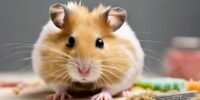Why Is My Hamster Hoarding Food? Understanding Natural Behaviors
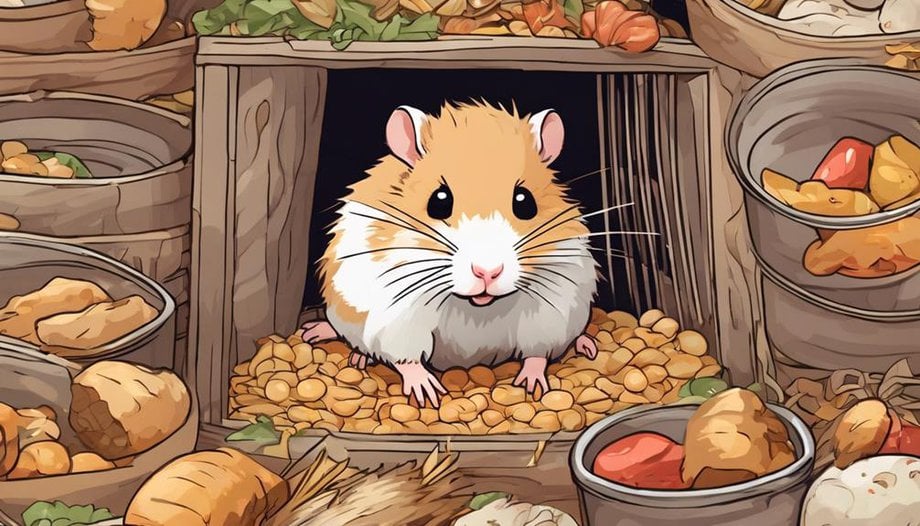
Hamsters hoard food as a natural instinct for survival and storing resources. This behavior allows them to have access to food even when it's scarce, ensuring their well-being.
Understanding this innate drive sheds light on their hoarding habits and overall health.
Evolutionary Roots of Hoarding Behavior
In the intricate tapestry of evolutionary biology, the origins of hoarding behavior in hamsters can be traced back to their innate survival instincts and the adaptive advantages it conferred upon their ancestors. Evolutionary origins reveal that hamsters have developed sophisticated behavioral patterns over time, honed through the crucible of natural selection. The act of food caching, a cornerstone of hoarding behavior, is deeply ingrained in these tiny creatures as a result of their ancestors' need to secure sustenance in times of scarcity. This survival strategy allowed hamsters to thrive in challenging environments by stockpiling food for leaner days, ensuring their survival and that of their offspring.
Through eons of evolution, hamsters have fine-tuned their hoarding instincts, displaying remarkable foresight and efficiency in gathering and storing food. This behavior not only showcases the intelligence of these creatures but also highlights their ability to adapt to changing circumstances in the wild. Understanding the evolutionary roots of hoarding behavior provides a window into the intricate relationship between hamsters and their environment, shedding light on the remarkable strategies these animals employ to navigate the complexities of the natural world.
Hamster's Natural Survival Instinct
The hamster's natural survival instinct manifests in their meticulous food hoarding behaviors, a testament to their evolutionary prowess honed through generations of adaptation. These tiny creatures exhibit remarkable foraging behavior and natural instincts that have been finely tuned over time to ensure their survival in the wild. One of the key ways in which hamsters showcase their innate survival strategies is through food caching, where they strategically gather and store food for future consumption.
To illustrate the hamster's natural survival instinct further, let's delve into a comparison between their behaviors and those of their wild counterparts:
| Wild Hamsters | Domestic Hamsters |
|---|---|
| Seek out diverse food sources in their environment | Display similar foraging behavior when provided with various food items |
| Utilize complex burrow systems for nesting and food storage | Showcase food caching behavior by hoarding food in hideouts within their habitat |
| Exhibit cautious behavior when approaching potential threats | Retain an innate sense of caution and vigilance when interacting with unfamiliar stimuli |
In essence, the hamster's natural survival instinct is deeply ingrained in their DNA, guiding their every move as they navigate their environments with a blend of curiosity and caution.
Hoarding as a Territorial Behavior
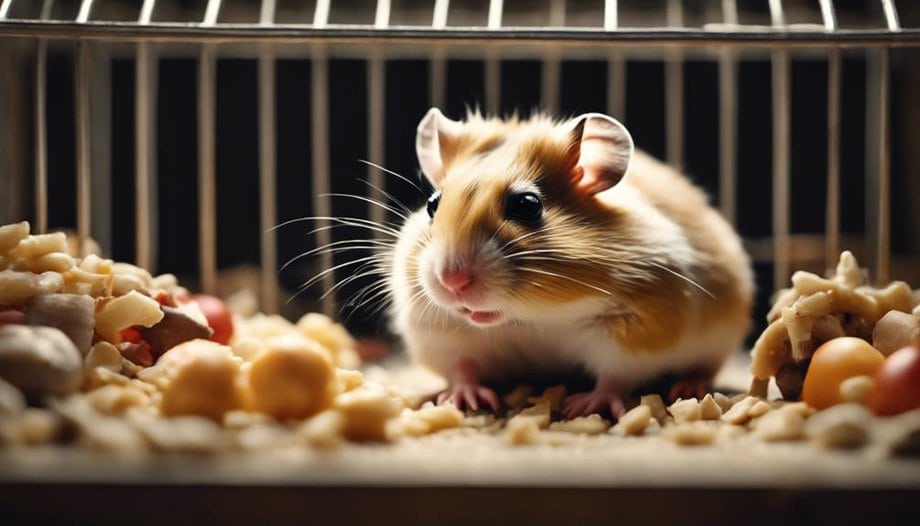
Evidencing their territorial nature, hamsters exhibit hoarding behaviors as a strategic means to assert dominance and secure resources within their environment. By creating hidden stashes of food within their territorial boundaries, hamsters establish control over essential supplies, ensuring their survival even in times of scarcity. This instinctual behavior stems from their wild ancestors' need to forage efficiently and safeguard against potential threats.
In the wild, hamsters defend their territories fiercely, using hoarded food as a buffer against intruders and as a vital resource during unfavorable conditions. This hoarding instinct not only serves as a practical survival strategy but also reflects the hamster's innate drive to maintain autonomy and security within its environment.
Understanding hoarding as a territorial behavior sheds light on the intricate dynamics of hamster psychology. It highlights their natural inclination to establish and protect their living spaces, emphasizing the importance of respecting their foraging instincts and territorial boundaries in captivity. By acknowledging and supporting these behaviors, hamster owners can create enriching environments that honor their pets' innate needs for freedom and security.
Impact of Hoarding on Hamster's Health
Asserting their dominance through strategic hoarding, hamsters' obsessive collection of food can have profound implications on their overall health and well-being. While hoarding is a natural behavior for hamsters, it can lead to various health concerns if not managed properly.
One primary concern is the nutritional impact of hoarding behavior. Hamsters may selectively hoard certain types of food, leading to an unbalanced diet that lacks essential nutrients. This can result in deficiencies that affect their energy levels, immune system, and overall vitality.
Additionally, hoarding habits can create an environment where food spoils quickly, attracting pests and causing contamination. Ingesting spoiled or contaminated food can lead to digestive issues and potentially severe illnesses for hamsters.
It's crucial for hamster owners to monitor their pet's hoarding behavior, ensure a varied and balanced diet, and regularly clean out hoarded food to prevent health risks. By understanding the implications of hoarding on a hamster's health, owners can promote a safer and healthier living environment for their beloved pets.
Different Types of Hoarding in Hamsters
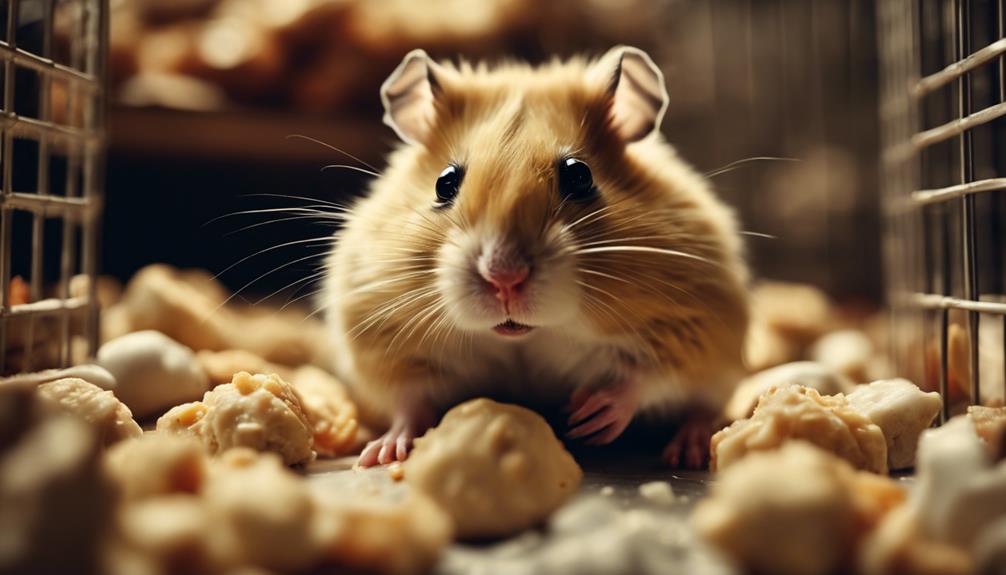
Within the world of hamsters, intricate hoarding behaviors manifest in various forms, offering a glimpse into their complex nature.
Instinctual tendencies drive these tiny creatures to stash away food, ensuring their survival in the wild.
Additionally, seasonal fluctuations and social interactions play pivotal roles in shaping the diverse hoarding dynamics observed among hamsters.
Instinctual Hoarding Behaviors
Hamsters exhibit various types of instinctual hoarding behaviors, showcasing their natural inclination to store food for future consumption. These hoarding instincts are deeply embedded in their genetic makeup, stemming from their ancestors' survival tactics in the wild.
Hamsters, through their food storage behaviors, demonstrate a remarkable ability to plan ahead and ensure sustenance during times of scarcity. Whether it's stuffing their cheeks to maximum capacity or meticulously hiding food in various corners of their habitat, these tiny creatures display a strategic approach to securing nourishment.
Understanding and respecting these innate tendencies not only enriches our bond with these furry companions but also allows them the freedom to express their wild instincts in a safe and nurturing environment.
Seasonal Food Storage
In their seasonal food storage practices, hamsters exhibit a fascinating array of hoarding techniques that reflect their innate survival instincts and resourcefulness. When faced with food scarcity, these tiny creatures rely on their natural instincts to ensure their sustenance throughout changing seasons.
Some of the food preservation techniques and seasonal foraging behaviors observed in hamsters include:
- Bulking Up: Hamsters tend to hoard more food in preparation for winter months when resources may become scarce.
- Selective Hoarding: They show a preference for hoarding certain types of food that are higher in energy content, ensuring they've access to vital nutrients.
- Hidden Stashes: Hamsters often store their food in multiple locations within their habitat, safeguarding against potential losses.
In their meticulous ways, hamsters navigate the challenges of seasonal fluctuations with grace and efficiency.
Social Hoarding Dynamics
Navigating the intricate social dynamics of hoarding, hamsters exhibit various types of resource accumulation behaviors that highlight their adaptability and communal strategies for survival. In the realm of hamster social hierarchy, food sharing plays a crucial role in maintaining cohesion within a group. Hoarding competition and cooperation dynamics are seen as hamsters work together to secure resources for the collective benefit. While some individuals may hoard food for personal gain, others engage in cooperative hoarding, where resources are shared among group members based on need. This blend of individualistic and cooperative behaviors showcases the complexity of hamster social structures and the flexibility they possess in adapting their hoarding strategies to ensure the group's overall welfare.
| Types of Hoarding in Hamsters | Description | Example |
|---|---|---|
| Individualistic Hoarding | Hoarding food for personal use | One hamster storing food in its burrow |
| Cooperative Hoarding | Sharing resources within the group | Group of hamsters pooling food together |
Factors Influencing Hoarding Behavior
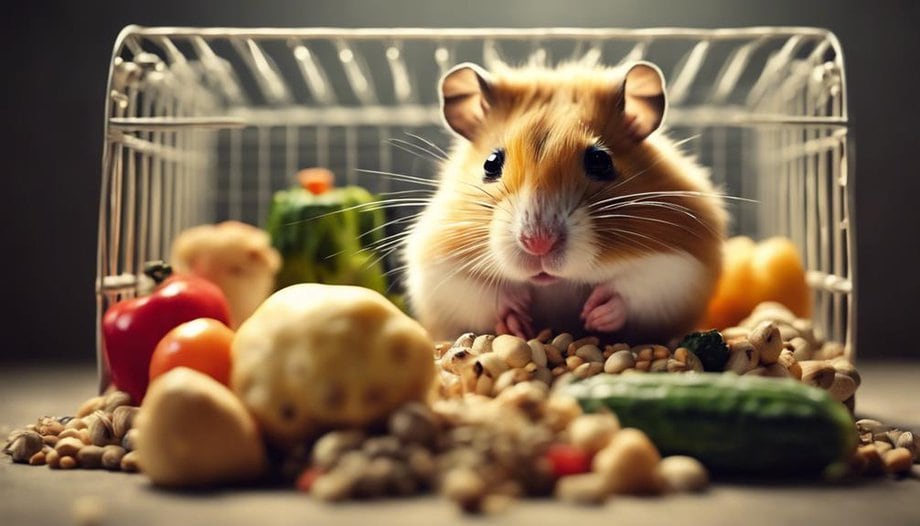
One must delve into the intricate web of environmental stimuli that can significantly influence a hamster's food hoarding behavior. Understanding the factors that shape this natural behavior can shed light on why hamsters exhibit such tendencies. Here are three key influences:
- Environmental Influence and Genetic Predisposition: The environment in which a hamster lives plays a crucial role in its hoarding behavior. Factors such as the availability of food, the size of the living space, and the presence of other hamsters can all impact the hoarding instincts. Additionally, genetic predispositions inherited from previous generations can also contribute to the hoarding behavior seen in hamsters.
- Behavioral Conditioning: Like many animals, hamsters can be influenced by behavioral conditioning. Positive reinforcement, such as receiving treats for hoarding food, can strengthen this behavior. On the other hand, negative experiences related to hoarding, like food scarcity or competition with other hamsters, can also shape their hoarding habits.
- Social Interactions: The social dynamics within a hamster community can greatly affect their hoarding behavior. Dominant hamsters may hoard more food as a way to exert control, while more submissive ones may hoard to ensure they've enough resources. Social hierarchies and interactions can thus play a significant role in a hamster's hoarding tendencies.
Understanding Hoarding Vs. Overeating
Understanding the distinction between hoarding and overeating is essential for comprehending a hamster's natural behaviors. Hamsters hoard food as a survival instinct, rooted in their wild ancestry. They store excess food in their cheek pouches to ensure a constant supply in times of scarcity. This behavior can be observed through food preferences and behavioral cues. Hamsters tend to hoard foods high in fat and protein, essential for their energy needs.
On the other hand, overeating in hamsters can lead to health issues such as obesity and digestive problems. Monitoring feeding schedules and practicing portion control is crucial in preventing overeating. Hamsters, if given unlimited access to food, may consume more than they need, leading to weight gain and potential health risks.
Promoting Mental Stimulation for Hamsters
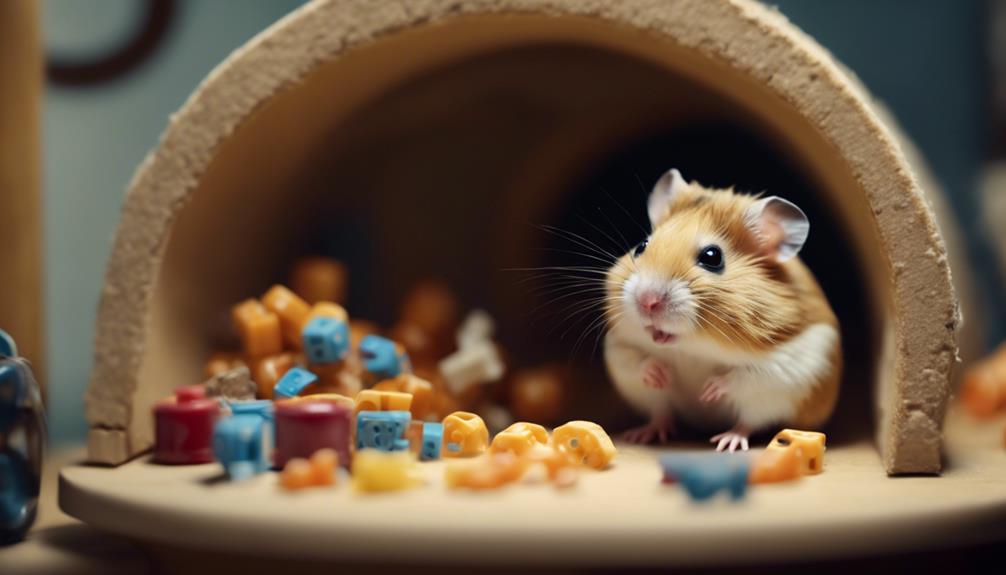
In the realm of hamster care, enhancing their environments with stimulating activities and providing interactive toys is paramount. These initiatives not only keep our furry friends physically active but also nurture their mental well-being.
The importance of mental stimulation for hamsters can't be overstated, as it contributes to their overall health and happiness.
Enriching Hamster Environments
Enhancing the living environment for hamsters is crucial for fostering their mental stimulation and overall well-being.
- Environmental Enrichment: Providing a variety of hiding spots, tunnels, and climbing structures can mimic the hamster's natural habitat, promoting exploration and reducing stress.
- Behavioral Benefits: Introducing novel objects like cardboard tubes or wooden chew toys encourages foraging behaviors, keeping the hamster mentally engaged and physically active.
- Cognitive Stimulation: Rotating toys and rearranging the cage layout regularly challenges the hamster's cognitive abilities, preventing boredom and promoting a healthy, curious mind.
Creating a dynamic and engaging environment for hamsters not only enriches their lives but also allows them the freedom to express their natural behaviors, leading to happier and healthier pets.
Interactive Toy Options
Introducing a diverse selection of interactive toys can significantly enhance a hamster's mental stimulation, encouraging curiosity and physical activity in their daily routines. Enriching playtime for these small, intelligent creatures is key to their overall well-being.
Interactive puzzles, such as treat-dispensing toys or maze-like structures, provide mental challenges that keep hamsters engaged and entertained. These toys not only stimulate their minds but also promote physical exercise as they navigate through the obstacles to reach their rewards.
Mental Stimulation Importance
Promoting mental stimulation in hamsters is essential for their overall well-being and cognitive development. To enhance their mental health and prevent boredom, consider the following:
- Enrichment activities: Providing a variety of enrichment activities such as tunnels, ladders, and running wheels can keep hamsters physically and mentally engaged.
- Interactive toys: Interactive toys like puzzle feeders or treat balls can challenge your hamster's problem-solving skills and provide entertainment.
- Boredom prevention: Regularly rotating toys, creating new play areas, and hiding treats around the cage can help stave off boredom and keep your hamster mentally stimulated.
Frequently Asked Questions
How Can I Train My Hamster to Stop Hoarding Food?
Positive reinforcement prompts playful hamsters to pass on hoarding habits. Engaging in environmental enrichment and playtime is paramount. Behavior modification thrives when hamsters encounter diverse stimuli. Enjoying freedom fosters fruitful progress and prevents hoarding.
Are There Any Specific Foods That Hamsters Are More Likely to Hoard?
Hamsters have specific foods they prefer to hoard, driven by their foraging instincts. Nutritional preferences influence their storage habits, with items like nuts, seeds, and grains being popular choices. Understanding their natural behavior aids in catering to their needs.
Can Hoarding Behavior in Hamsters Be a Sign of Stress or Anxiety?
When hamsters hoard food, it can be a sign of stress or anxiety. Like a squirrel storing nuts for winter, hamsters may hoard in response to behavioral triggers. Providing environmental enrichment and bonding activities can help them cope.
Do Hamsters Hoard Food Differently in the Wild Compared to in Captivity?
In the wild, hamsters exhibit foraging behavior as an adaptation for survival, storing food in various locations. Domestic hamsters, mirroring this instinct, hoard food to mimic their natural tendencies, a trait that persists across wild and captive environments.
Is There a Way to Prevent My Hamster From Hoarding Food Excessively?
To prevent excessive hoarding, provide food enrichment like scatter feeding to stimulate natural foraging behaviors. Implement behavioral training to redirect hoarding tendencies. Encourage freedom by offering varied activities and toys. Trust in the hamster's innate instincts.

